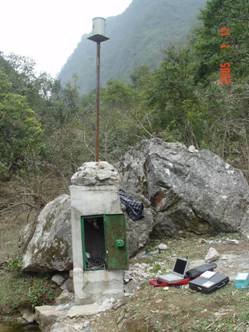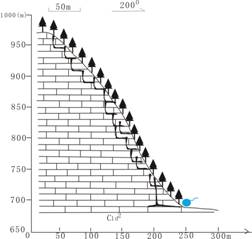Jiang Guanghui, Guo Fang, Li Huaju, Sun Hailong
Karst Dynamics Laboratory, Institute of Karst Geology, MLR, Guilin 541004
Abstract: The spring outcrops in the epikarst of karst forest Fengcong area in South China was selected for the study object. According to continuously auto-monitoring result of the spring’s discharge, pH, electrical conductivity, temperature and rainfall we found that the threshold value of runoff in the epikarst was 11mm. And we analyzed the variation of spring’s pH, EC, temperature under different rainfalls. Generally the spring’s pH shows temporally decreasing after raining. The spring’s EC increases temporally. While the spring’s water temperature shows a temporal up or down which is determined by the difference of temperature between the spring water and rainfall. According to the spring’s different response to rainfall from faintness to intensity, the variation can be classified to three grades. The first grade is characterized by no change after rain in discharge, pH, EC and water temperature. The second grade means slow and little change in a part of these indexes. The third grade shows distinctly change in all of the four indexes. For epikarst the threshold value is the mark to distinguish effective rainfall and invalid rainfall. It has great meaning to understand the threshold value of runoff in the epikarst because it is an important parameter for the study on the formation of groundwater resources.
Key words: epikarst, threshold value of runoff, karst forest, auto-monitor
1 Introduction
Epikarst is the surface weathered zone of carbonate rock. It is characterized by higher and more homogeneous permeability compared to the lower aeration zone. Epikarst split rainfall into three parts. One is runoff, one is groundwater stored in epikarst, and the other is infiltrated to aeration zone through epikarst [1, 2]. Epikarst is very important to water cycle in karst area. Many studies have only emphasized seepage in epikarst, but omitted water flow in the horizontal direction [2, 3]. The secondary vertical fracture and gravity are benefit to the development of vertical fractures of epikarst. But in fact the obliquity of stratum is generally slight. It is another vadose space where horizontal flow runs. So horizontal flow in epikarst is important and the formation of epikarst’s spring is related to horizontal flow. Spring developed in epikarst is very normal in karst mountain area in South China. It provides water for drought and poor country [4]. But with destroy of forest, epikarst springs become seasonal and even disappear. This is because that forest can absorb rainfall and reduce intensity of rainfall and improve the quality of soil so as to increase infiltration [5, 6]. In forest karst mountain area rainfall is absorbed firstly by forest and soil, then the rest rainfall reaches epikarst. The higher and more homogenous permeability of epikarst render the hill slope absorb rainfall effectively. But when the vegetation reduces the structure of soil will be destroyed and soil erosion will occur on the steep slope [7]. As a result the fracture of epikarst will be filled by impervious clay so epikarst becomes less pervious. We call the vegetation and soil as the protection layer of epikarst. The total of the largest amount of rainfall volume absorbed by protection layer and the minimum filed capacity is considered to be threshold value. We hope the protection layer develops well and has high threshold value. In this research the threshold value of the epikarst under forest condition is given by analyzing more than one year’s rainfall. In the same time the variation of the spring’s pH, EC and temperature are studied to help judging the infiltration.
2 Studied zone
Maolan is situated in Libo county, South Guizhou Province. (Fig.1) The climate of the study area is considered to be subtropical climate, with an annual rainfall of 1752mm. Maolan Karst Forest National Reserve is a rare karst forest centralized distributing region in China with an area of 21100ha. The forest covering ratio reaches 87.54 percent. The relief is the typical peak forest. The stratum is limestone of carboniferous. The soil covering rock slope is thin and discontinuous It lies in SE wing of Libo syncline basin. Zhou Zh.X. et. al of the Guizhou Agriculture College organized a team to survey the Maolan Reserve from 1981 to 1984. They found rich groundwater stored in the surface layer of limestone in the forest. Up layer groundwater outcropped in the edge of depressions in the form of spring [8]. It provided water resources for local people. The formation of rich water resource was related to the forest, but some detail problem of how they formed wasn’t clear yet. In the aim of this we select an epikarst spring to study infiltration in epikarst. The study is also helpful to deal with serious rock desertification occurred in South of China.
The selected epikarst spring is at the bottom of a hill slope. The angle of the slope is 55°. The high of the slope is nearly 300m. The slope is covered by forest. The spring’s discharge varies from 0.027 to 6.984(l/s). The spring’s water represents Ca-HCO3 type.

Fig.1 Location of the study area
3 Methods
In Fig.1 below the house is the outlet of the spring. In Oct. 2003 a multiple-parameter auto-monitoring apparatus made by Australian Greenspan Technology Pty Ltd. is installed in the house. Water lever is measured using a depth sensor gauge with a range of 0-50m and an accuracy off ±15mm. The electrical conductivity has a range of 0-5000μs/cm and an cccuracy of ±5μs/cm. pH has a range of 0-14 and an accuracy of ±0.2. The data logger continuously records rainfall, water level, water temperature, pH and EC with a monitoring interval of 15 minutes. Stored data is collected in-situ monthly. A friangular-notch weir is built in order to calculate the recharge. Ca, HCO3, EC, pH, water temperature are measured in-situ too using a portal apparatus of WTW made in Germany. Water sample is collected at the spring outlet with a plastic bottle monthly and send to the laboratory within 3 days. They are analyzed in laboratory for chemical constituents such as sodium, potassium magnesium chloride, bicarbonate, sulphate, nitrate and total dissolved solids (TDS). Sodium and potassium are measured by flame photometry, magnesium, bicarbonate, sulfate, nitrate and chloride by burette.


Fig.2 The apparatus in the study zone and the profile map of epikarst spring
4 Results and Discussion
The threshold is a special rainfall intensity, which means rainfall intensity is just larger than the infiltration speed in surface so as to reach run off condition in Horton theory. According to interface runoff theory only when rainfall or rainfall intensity exceeds the threshold can runoff in interface occur. Runoff in epikarst occurs in the interface between epikarst and unsaturated zone where karst undeveloped relatively, and rainfall must reach the request of threshold value. Runoff in epikarst is approximated to the soil flow which happens in the interface of two different porosity soil due to different permeability of epikarst and low aeration zone. Runoff in epikarst will occur when rainfall intensity exceeds conductivity of unsaturated zone. But in fact things are more complex. In the process of rain, rainfall is absorbed firstly by the protection layer, and then reaches epikarst. Although the field capacity is defined within soil aquifer, gravity water in epikarst can be produced after epikarst absorbs some water. The water absorbed by epikarst can be considered as field capacity too. Because distribution of erosion fracture in epikarst isn’t homogenous, field capacity in epikarst will vary in space with a result of wide range variety of field capacity and different order of runoff time. The threshold of epikarst should be defined as the total of maximum protection cut and minimum field capacity of epikarst. This kind of threshold almost can’t be observed in field because there are always some water in the protection layer and epikarst. Approximate value can be got in field observation.
Not only water discharge, but also pH, EC and water temperature have disciplinarian variety when rainfall infiltrates into epikarst. This variety disciplinarian is determined by the self-character of rainfall and epikarst. For the same epikarst the variety of discharge and so on is controlled by rainfall, the water status of protection layer and old epikarst groundwater. The rainfall in Maolan is rich in spring and summer but little in autumn and winter. Rainfall intensity is large in summer but small in the other seasons. This feature of precipitation results in different rainfall recharge for epikarst in rainy season and dry season.
Rainfall in summer can lead to drastic variety of discharge, pH, EC and water temperature. This is because in rainy season, rainfall pH value is lower than that of epikarst groundwater, which leads to temporally go down of pH. But pH value will increase after water reaction with limestone, and as a result the final pH value is equal to or higher than the original value. EC usually goes up after rain, because rain reduces enhancement of CO2 part pressure in epikarst [9]. EC return to original value or keeps a higher value after CO2 is consumed by karst procession. EC temporally goes down when rainfall intensity is high enough because rapid infiltration renders uncompleted water-rock interaction. Water temperature shows temporally down after rain, because the temperature of rain is higher than groundwater. But in dry season pH keeps unchangeable or goes up due to insufficient recharge. Rainfall in dry season leads to several kinds of change model in EC, which depend on the state of protection layer. The variety of temperature is related to its difference between rain water and groundwater. When the difference of temperature is positive, temperature of spring shows temporally up, otherwise down. Synthetic analysis of discharge, pH, EC and water temperature under different rainfall is the way to determine the threshold of epikarst runoff. The discharge, pH and so on won’t change when no rain water become the epikarst gravity water, otherwise they will have a series of variety.
The variety of epikarst spring can be classified into three grades after analyzing the change of rainfall and epikarst spring from Oct. 2003 to Apr. 2005. The first grade is characterized by no change after rain in discharge, pH, EC and temperature. The second grade means slow and little change in a part of these indexes. The third grade means distinctly change in all of four indexes. It is obviously that three grades’ change of epikarst spring is related to the humid, temperature, CO2 concentration of the protection layer. When no rain’s recharge change into gravity water in epikarst it will lead to the first grade change. When little rain’s recharge change into gravity water the second grade change will happen, and when a lot of rain’s recharge change into gravity water it will show the third grade’s change. We can find threshold value from the first grade change or the second grade change.
Tab.1 Rainfalls that don’t result in variety of epikarst
Rainy date | No rain days before this rain | Rainfall (mm) | Lasting time (h) | Rain intensity (mm/h) | The maximum rain intensity in 15 minutes (mm) |
2003-10-29 | 1 | 2.5 | 1.5 | 1.67 | 0.5 |
2003-11-25 | 26 | 2 | 3.5 | 0.7 | 0.5 |
2003-11-26 | 0.8 | 2 | 1.5 | 1.33 | 0.5 |
2003-12-6 | 9 | 4.5 | 3 | 1.5 | 1.5 |
2003-12-8 | 2 | 5 | 3.5 | 1.43 | 1 |
2003-12-10 | 2 | 3 | 2 | 1.5 | 1 |
2004-2-7 | 23 | 4.5 | 3.25 | 1.38 | 1 |
2004-2-23 | 16 | 5.5 | 2.25 | 2.44 | 1.5 |
2004-9-21 | 29 | 6.5 | 1 | 6.5 | 2.5 |
2004-9-25 | 4 | 6.5 | 0.75 | 8.67 | 3 |
2004-10-13 | 17 | 2.5 | 1.25 | 2 | 0.5 |
2005-2-25 | 19 | 5 | 7.5 | 0.67 | 1 |
2005-4-19 | 19 | 2.5 | 1.5 | 1.67 | 0.5 |
Tab.2 Rainfall result in weak variety of epikarst
Rainy date | No rain days before this rain | Rainfall(mm) | Last time (h) | Rain intensity (mm/h) | The maximum rain intensity in 15 minutes (mm) |
2003-1-10 | 30 | 11 | 2 | 5.5 | 4.5 |
2004-1-15 | 2 | 4 | 1 | 4 | 2 |
2004-3-17 | 23 | 6 | 1 | 6 | 2.5 |
2004-4-13 | 6 | 2.5 | 2.5 | 1 | 0.5 |
2004-6-15 | 10 | 2.5 | 3.25 | 0.77 | 0.5 |
2004-6-17 | 2 | 2 | 0.75 | 2.66 | 1 |
2004-7-30 | 10 | 3.5 | 0.75 | 4.67 | 2 |
2004-8-12 | 5 | 2.5 | 1.25 | 2 | 1 |
2004-10-14 | 18 | 4.5 | 3.5 | 1.29 | 0.5 |
2004-11-4 | 22 | 13.5 | 2 | 6.75 | 7 |
For example, the total of three bouts of rainfall from Oct.25,2005 to Oct.28,2005 is 23.5mm. The rainfall is 4.5mm、10mm、6.5mm respectively with an average rain intensity of 0.66mm/h. The rainfall intensity is 1.29mm/h、1.18mm/h、1.44mm/h respectively, with the maximum rainfall in 15 minutes of 1mm. After the first rain pH, EC, water temperature and water level have no obvious change, showing the first rain has a bad recharge effect for epikarst, all of them are cutting and remaining by vegetable and soil. Water level still has no obvious change after the second rainfall, while pH, EC and water temperature become changing one after another, showing pH, EC and water temperature are sensitive indication function for rainfall recharge. The sensitive degree is higher than water level, which is relative to the apparatus capability. The variety of pH, EC and water temperature are lagged by raining 5~11 hours (from centralize rain beginning to pH and other indexes having obvious change). The variety speed of EC, pH and water temperature is 1.6/h、-0.01/h、-0.006/h respectively. After the third rain all of water level, water temperature and pH are variety due to basing on two rainfalls before this, but the variety of water level is very weak. All of the variational lag times of EC, pH and water temperature are 4 hours. The variety speed of EC, pH and water temperature is 3.25/h、-0.04/h、0.01/h respectively. Lag time and variety speed of three bouts of rainfall presenting decreased and increased by degrees trend showing the recharge becomes better and better. The different variety of index such as water level after three rainfalls indicates that the wetness or drought degree of the protection layer of epikarst (vegetable and soil) having an important impact on the recharge effect of epikarst. The index of EC, pH and water temperature have a good indication function for recharge effect of epikarst. We can use them as the index of reflection for recharge effect of epikarst. Lag time and speed of ascend or descend can reveal the recharge effect of fast or slow, but not the recharge quantity.

Fig.3 Three grade changes in epikarst after three rains

Fig.4 the second and third grade changes in epikarst after two similar rains

Fig.5 The third grade change in epikarst after four different rains
Two rainfalls from Apri.13, 2004 to Apri.15, 2004 reveal the different recharge effect from two similar rainfalls. Before these two rainfalls there are 6 days of no rain and it has rain within 24 hours respectively. The first rainfall leads to the second grade change, while the second has the third grade change. The rainfall and rain intensity of the two rainfalls are 2.5 mm, 3 mm;1 mm/h, 2.4 mm/h respectively. The characteristic of the second grade change is a part of indexes such as water level and water temperature having no obvious variety, while others have small extension or slowly variety. For example, after the first rain the variety lag time of EC and pH are three and one hour. The variety speed is 0.8/h, -0.01/h respectively. The characteristic of the third grade change is all of the four indexes having obvious change. For instance, after the second rain all of the four indexes have disciplinarian changing. We will discuss this disciplinarian detailed in another paper. The variety lag time of water level, water temperature, EC and pH is 1, 2.75, 2.25, 4.5 hours respectively. The variety speed is 0.7 cm/h, 0.008 cm /h, 7.11 cm /h, 0.02 cm /h respectively.
The variety of water level and other indexes are very obvious when rainfall and rain intensity accretion distinctly in rainy season, indicating that the effect of rainfall recharge is very well. High intensity rainfall can bring to obvious variety of index such as water level, which taking important part in rainfall recharge. For example, four bouts of rainfall from July 20 to 22 in 2004 illuminated this disciplinarian very well. No rain occurred before July 20, 2004, after that the rainfall can be divided into four phases, with time interval of 0.5~9hours.The rainfall, rain intensity and the maximum rain in 15 minutes of these four rainfalls are 30mm,19mm, 21.5mm, 14mm;6.31mm/h, 3.8mm/h, 4.53mm/h, 3.5mm/h;5mm/15min, 4.5mm/15min, 4mm/15min,
3.5mm/15min, respectively. Water level and so on change at the maximum intensity rain heels. Each of the variety speed after four rains of water level, water temperature, EC and pH is 0.026m/h、0.016m/h、0.014m/h、0.023m/h; 0.192/h、0.044/h、0.095/h、0; 5.23/h、4.44/h、1.5/h、2/h;pH-0.04/h、-0.018/h、-0.048/h、-0.034/h, respectively. Four rainfalls induce the variety of water level and other indexes are obvious. The notability degree of the first rainfall is higher than the other rainfall, this not only because the rainfall and rain intensity of the first rainfall is the maximum, but also it has relationship with the state of epikarst. Under the condition of before the influence of the first rainfall end, the second rainfall’s influence must be interfered by the first rainfall.
The maximum rainfall leading to the first grade change is considered to be the approximate threshold value of runoff in epikarst. From the presenting observation we can see several rainfalls are near to the threshold value. First there are nine days of no raining before rain in December 12, 2003. The total rainfall is only 6.5mm from Oct. 30, 2003 to Dec. 5, which lasting 37 days. The total rainfall lasting time is 6.5 hours, under this condition the protection layer of epikarst is very dry. The total lasting time for the rainfall of Dec. 6 to 8, 2003 is 43 hours with the total rainfall of 9.5mm, and rain intensity of 0.22mm/h respectively. We can see the lasting time is very long, and it should have evaporation loss during this rain. The observed spring has no change after this rainfall. Second there is no rain in 29 days before Sept. 21, 2004, while the total rainfall for two rains in 21 and 25 is 13mm, with the interval time of 96 hours, indicating that evaporation loss happens between these. The water chemistry of the observed spring has no change too. Third there is 30 days of no rain before Jan. 10 2005. The total of this rain is 11mm and rain intensity is 5.5mm/hr. Tthe spring showed the second grade change after this rain. From these three examples we can take the average rainfall of these rain11mm as the threshold value of the epikarst.
5 Conclusion
Epikarst is an important aquifer in karst mountain area in South China. It can store rainfall and transport water to low aeration zone, which leads to epikarst outcrop in the special structure situation in the form of epikarst spring, providing plenty of water for local people and the need of production. The formation of water in epikarst is related to rainfall and the protection layer. So plentiful epikarst water resource won’t actually happen in which rich rainfall exits, the reason is slope flow accounts for great percent in bad rainfall infiltration, while the percent of infiltration quantity is small. It is obvious that it have great meaning for arrangement of rainfall from epikarst. It has plenty of water resource in epikarst in karst mountain area with forest covering. Many studiers think that groundwater having binary structure in karst forest mountain area, and they usually take special consideration for the epikarst groundwater. But we think that the plentiful epikarst groundwater resource in karst mountain area is contributing to the higher threshold function of epikarst protection layer.
Acknowledgement Financial support was provided the China Geological Survey. The authors wish to specially thank Prof. Yuan Daoxian, whose critical comments greatly improved the manuscript.
References
[1] Yuan Daoxian, Dai Aide, Cai Wutian et al. Karst water system of a peak cluster catchment in south China’s bare karst region and its mathematic model. 1996, Guangxi normal university publishing house.
[2] Alexander Klimchouk, Towards defining, delimiting and classifying epikarst: Its origin, processes and variants of geomorphic evolution, Speleogenesis and Evolution of Karst Aquifers, 2004, 2(1):1-13
[3] T. Clemens, D. Hiickinghaus, R. Liedi, Mauter, Simulation of the development of karst aquifers: role of the epikarst, Int Journ Earth Science, 1999, 88:157-162.
[4] Yuan Daoxian, The environment geological and hydrological ecosystem problem in karst area, South Land Resource, 2003, 1:22-25.
[5] Li Zhenji, Chen Xiaolin, Zhen Hailei, et al, Ecology, 2000, Science publishing house.
[6] Cheng Genwei, Yu Xingxiao, Zhao Yutao, et al. The hydrological cycle and its mathematical models of forest ecosystem in mountains, 2004, Science publishing house.
[7] Cao Jianhua, Yuan Daoxian, Zheng Cheng, et al, Karst ecosystem constrained by geological conditions in Southwest China, Earth and Environment, 2004, Vol.32, No.1:1-8
[8] Zhou Zhengxian, et al. Collection of science review for Maolan karst forest. Guiyang:
[9] Liu Zaihua, Chris Groves, Yuan Daoxian, et al, Study on the hydro chemical variations caused by the water-rock-gas interaction, an example from the Guilin Karst Experimental Site, Hydrogeology & Engineering geology, 2004, Vol.30, No.4:13-18.










